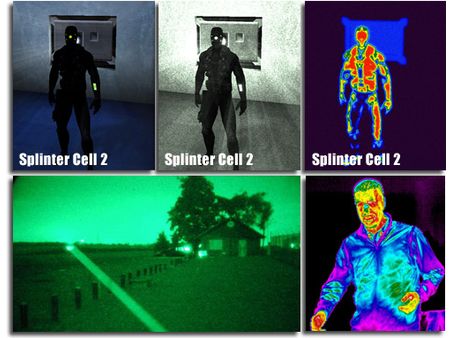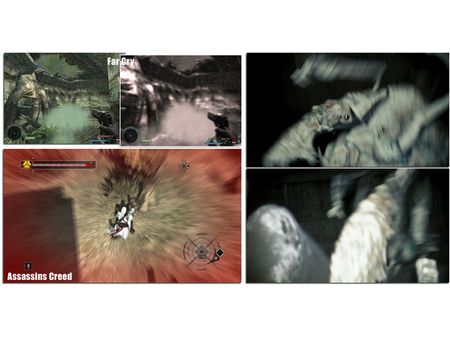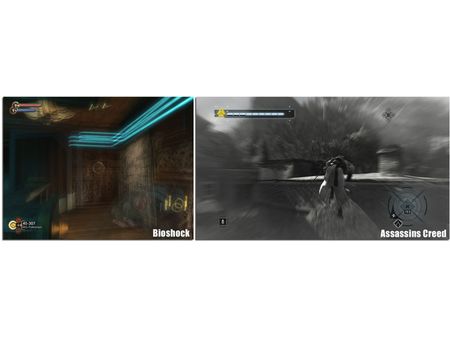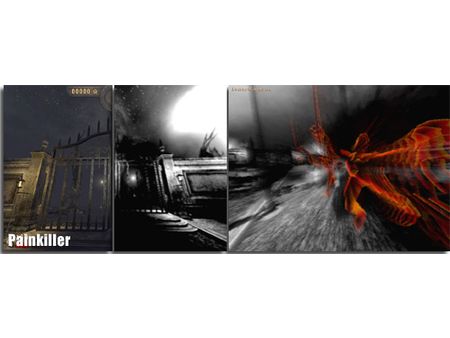Gaming Effects Versus Hollywood, Part II
Shader Effects
The pixel shaders of the graphics cards enable even more special effects that simplify the life of the gamer and are even important for survival in many situations. One area is the simulation of night vision goggles and the infrared light due to a heat sensing camera. In Splinter Cell, for example, you must trace the infrared signatures of mines or recognize residual heat on a panel of buttons in order to uncover the right access code.
Physical injury and poisonous gas cannot be felt, tasted or smelled—not on the PC nor in a movie—so these dangers require optical or acoustic signaling. One method of showing injury is that vision becomes less focused as the character has tears in his or her eyes, bones crack, or the character coughs in pain. In addition, the screen turns red, and the stronger the coloring, the more serious the injuries. In multi-player shooter games this is sometime unfair, as you are unable to get away under heavy fire, and lose orientation due to the changed color.
If a character is drugged, poisoned, or has simply drunk too much vodka, the world begins to swim and you see everything twice. At high concentration levels, it is possible to create tunnel vision in which you can better fix the target.
If a character turns into a demon, the environment changes, and enemy creatures are highlighted more. Of course this is difficult to check, as in the real world one rarely gets the chance to change into a prince of hell.
Get Tom's Hardware's best news and in-depth reviews, straight to your inbox.
-
roynaldi Wasser -1, Wasser -3, -5, Wasserfall, Bewegungsunscharfe*.....Reply
German Tab names for the pics... Very Nice guys!
*movementSharpness!?!? -
neiroatopelcc Part 1 had german names for the images too. I don't see how that is of any importance though as the titles for the respective pages were translated. Some of the games were in german too in case you missed it btw (bioshock amongst others)Reply
Anyway. I read the article and can't help to somehow be disappointed. Sure it's well written and explained, but somehow there's something missing! it seems to be more of the first part and not enough hollywood somehow. There are like 85% gaming screenshots, 8% reallife and the remaining 7% are hollywood. Also the article only covers stuff hollywood uses and games do too - nothing mentioned of stuff that pc's cant do yet other than visual enhancements that aren't treated as manipulatable objects - but then hollywood doesn't really supply that either, as all their stuff is static each time it's displayed.
In short : not enough hollywood, and too much pc tech. -
thr3ddy roynaldiWasser -1, Wasser -3, -5, Wasserfall, Bewegungsunscharfe*..... German Tab names for the pics... Very Nice guys!*movementSharpness!?!?BewegungsunscharfeReply -
Why are there no examples of the Source engine in these articles? The physics is unparalleled in a lot of ways. The new cinematic physics engine? Hello? What they do with characters alone (mostly in animation/facial animation) is amazing. I also don't notice any Gears/UT3 examples, which is just weird.Reply
-
Tis a shame you mention water graphics and have no references to Uncharted.Reply
@Anony-Guy the first example was UT3 engine (stranglehold. I must admit though gears 2 had better water graphics. -
hellwig I remember a cool water effect in Giants. If you ran through a body of water, the water would appear to react to your legs, and waves of water would rush up against the them. Of course, this wasn't really the water reacting, it was just a secondary effect being drawn at the point where the legs met the water. It still looked cool for a game from 8 years ago.Reply
I'm surprised there were no examples of water from Serious Sam. SS had transparent water, shadows cast underneath by the ripples on the water surface, etc..., and again, all back in 2000/2001. The Serious Engine was so impressive when it came out, far better than Quake III and UT, the other options at that time. -
JonnyDough What they need is better ripple effects now. When you walk through water, your character needs to slow and teeter more. Each stride should make noise, not just a general noise of sploshing. When you drop a gun in water, it needs come out dripping wet. When you swim, you need to do it in lunges, not smoothly. When the tide rolls in, the sand needs to change a bit over time. Your footprints need to disappear with each wave, etc. These little things aren't that hard to implement, and should not be taking up much system resources. I think it's just laziness on the part of most developers. There's always this "time limit" and "budget" that interfere as well...but then you have a monster giant corporation like EA who is spending money on stupid things like SecuRom instead of producing great games that will make sales.Reply



